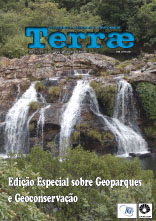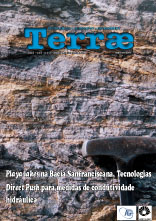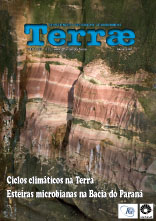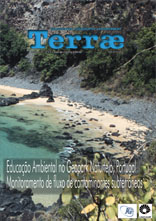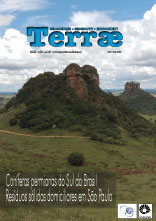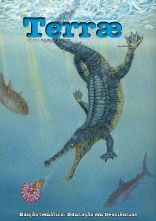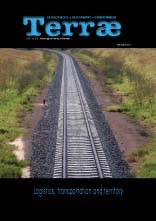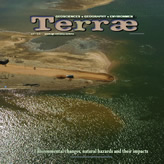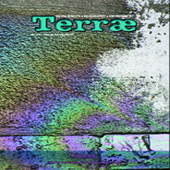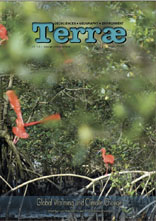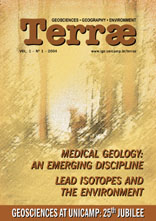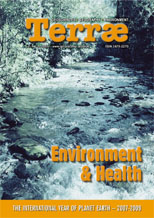Save the date / Call for papers
A revista Terræ publica simultaneamente as edições online de 2016 e 2017. As edições impressas acham-se temporariamente suspensas, pois os editores reconhecem que a internet oferece formas mais eficazes para disseminar rapidamente os resultados das pesquisas. As reformulações do periódico objetivam ampliar a abrangência, combinando redução de custos com rapidez de publicação. Cada vez mais a revista consolida a tendência de cobrir temas multidisciplinares que revelem formas de interação das Geociências com as diferentes áreas do conhecimento humano. A edição de Terræ 2017 é inteiramente dedicada ao tema GEOPARQUES.
A revista aceita trabalhos e comunicações em Português, Inglês e Espanhol.
Chamada de trabalhos / CALL FOR PAPERS
Uma vez recuperado o tempo de ausência na web, a edição de Terræ 2018 tornar-se-á uma boa opção para publicação de artigos científicos. O volume deverá reunir contribuições referentes a GEOÉTICA, tema que permite acomodar abordagens diferenciadas que revelem as inter-relações entre a sociedade e os ecossistemas terrestres.
O sistema de submissão e avaliação de artigos científicos está em pleno funcionamento, sendo feito exclusivamente pelo E-mail: terrae@ige.unicamp.br. Nosso sítio web está à sua disposição.
Esperamos sua visita e participação!
Os editores.
10/01/2018- 16:31 pm
Chamada de trabalhos/ Call for papers para o Volume 15, 2018
Novas contribuições são aceitas para o volume 2018 de Terræ.
Data limite 30.abril.2018
10/01/2018- 16:31 pm
Chamada de trabalhos/ Call for papers para os eventos:
VIII GeoSciEd 2018 – the 8th Quadrennial Conference of the
International Geoscience Education Organisation (IGEO)
– Geosciences for Everyone –
VIII Simpósio Nacional de Ensino e História de
Ciências da Terra / EnsinoGEO-2018
– Geociências para Todos –
Campinas – Sao Paulo – Brazil, July 2018
Acesse o site: http://www.ige.unicamp.br/geoscied2018/en/.
Data limite 11.fevereiro.2018
11/01/2018- 13:40 pm
Livro "Geologia do Brasil”, 2012: Reserve já seu exemplar, sem despesas de remessa.
Visite o endereço eletrônico: www.editorabeca.com.br
Os editores
Campinas, janeiro de 2018.
Environmental Geochemistry in Tropical and Subtropical Environments
Jörg Matschullat
Technische Universität Bergakademie Freiberg
de Lacerda L.D., Santelli R.E., Duursma E.K., Abrão J.J. (eds). 2004. Environmental Geochemistry in Tropical and Subtropical Environments. Heidelberg, Berlin, New York: Springer Verlag. 384p. ISBN 3-540-42540-3. |
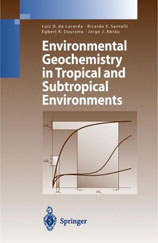 |
Years after Springer published a thin book on the same topic in its Lecture Notes series (Wasserman JC et al., eds., 1998: Environmental Geochemistry in the Tropics, Vol. 72), this rather long awaited book was recently released – a much more substantial contribution to the topic. This new work represents the growing self-confidence and impressive quality of colleagues working in tropical and subtropical environments of Argentina, Australia, Brazil, Colombia, France, Ghana, Mexico, the United States of America, and Sweden (with a strong bias on Brazil that reflects this countries activities). It is a selection that successfully attempts to demonstrate related research activities form terrestrial, coastal, and marine environments. It can by no means be comprehensive and the order of the individual contributions is sort of arbitrary – a different organization would have been just as possible.
The book contains 26 individual chapters, each written by individual authors or small groups of authors with the aim to reflect the current understanding and diversity of the topic. These chapters carry the following titles: 1) Regional climate changes: where and how; 2) Palaeoenvironmental reconstruction based on lacustrine organic matter: examples from the tropical belt of South America and Africa; 3) Catchment-lagoon-estuary-coast interactions of the Patos-Mirim system, South Brazil; 4) Relationships between simultaneous methane, nitrous oxide and carbon dioxide fluxes, and surface soil humidity and temperature in the Mata Atlântica subtropical forests, Brazil; 5) Modern strategies for environmental sample preparation and analysis; 6) The importance of assessing uncertainties related to linear calibration curves: a case study for flame atomic absorption spectrometry; 7) Sources of nonpolar lipids in aerosols over the city of Rio de Janeiro; 8) The provenance of prehistoric ceramic artefacts from the Amazon basin using geochemical tracers; 9) Exploring the cation exchange capacity of Massapé Paulistana vermiculite for heavy metal removal from aqueous solutions; 10) Variation of heavy metal content with depth in Sabana de Bogotá soils 11) Acid drainage of coal mining in Cundinamarca, Colombia; 12) Mercury pollution in Ghana: environmental impacts of artisanal gold mining in sub-Saharan Africa; 13) Water quality in the area of Colima volcano, Mexico; 14) The Pacific and Caribbean rivers in Columbia: water discharge, sediment transport and dissolved loads; 15) Reactive processes of organic matter in the Amazon river; 16) Organic carbon and nitrogen in particulate, colloid and dissolved phases from the Amazon river system; 17) Relationship of metal contaminant with acid-volatile sulphides (AVS) in tropical estuarine sediments: potential influence on metal distribution and bioavailability; 18) Modelling of circulation and water exchange in a hypersaline coastal lagoon: Lagoa de Araruama, Brazil; 19) Sediment oxygen and nutrient fluxes in three estuarine systems of SE-Brazil; 20) Hydrogeochemical characterisation of groundwater saline intrusion in the western shore of Céara, NE-Brazil; 21) Sepetiba Bay: environmental geochemistry of heavy metals in a subtropical costal lagoon; 22) Biogeochemical controls and concerns with trace metal accumulation in mangrove sediments; 23) Bioturbation effects of the sandprawn Callichirus Maior on sediment nutrient fluxes; 24) Trace metal occurrence and distribution in sediments from Mar Chiquita coastal lagoon, Argentina; 25) Geochemistry and spatial distribution of heavy metals in continental shelf sediments from two offshore oil fields in SE-Brazil; 26) Geochemistry of continental shelf sediments of the Céara coast, NE-Brazil; followed by a subject and a taxonomic index.
In his introductory chapter, Egbert Duursma presents some impressive evidence for regional climate changes from the Amazon region of Brazil, and from the Andean countries Argentina, Bolivia, Chile, Ecuador, and Peru, including an atmospheric temperature profile form Cartagena, Columbia that reaches into the stratosphere. His most important point is that climate change has its impact on environmental geochemical processes and much more collaboration is needed between meteorologists and geoscientists to better explain and model tendencies and trends. The following chapters are more "down-to-Earth" in their approach but still beautifully reflect the large variety of environmental geochemical activities and interactions with other fields of science. Everyone working in the field and dealing (not just) with tropical and subtropical climates will certainly appreciate the compilation. There certainly are quality differences between individual contributions but this does not question its overall value. In addition (and unfortunately not to be taken for granted) the book received a nice layout and tables and figures have received the necessary attention.
The original of this contribution appears in the Journal of Soils and Sediments in 2005.
A PDF reader is required to view the article files. Make the download here: Adobe Acrobat or Foxi


